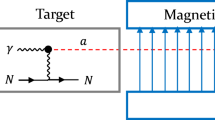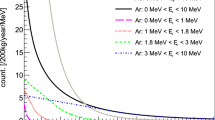Abstract
Antihydrogen holds the promise to test, for the first time, the universality of free-fall with a system composed entirely of antiparticles. The AEgIS experiment at CERN’s antiproton decelerator aims to measure the gravitational interaction between matter and antimatter by measuring the deflection of a beam of antihydrogen in the Earths gravitational field (\(\overline {\textrm {g}}\)). The principle of the experiment is as follows: cold antihydrogen atoms are synthesized in a Penning-Malberg trap and are Stark accelerated towards a moiré deflectometer, the classical counterpart of an atom interferometer, and annihilate on a position sensitive detector. Crucial to the success of the experiment is the spatial precision of the position sensitive detector. We propose a novel free-fall detector based on a hybrid of two technologies: emulsion detectors, which have an intrinsic spatial resolution of 50 nm but no temporal information, and a silicon strip / scintillating fiber tracker to provide timing and positional information. In 2012 we tested emulsion films in vacuum with antiprotons from CERN’s antiproton decelerator. The annihilation vertices could be observed directly on the emulsion surface using the microscope facility available at the University of Bern. The annihilation vertices were successfully reconstructed with a resolution of 1–2 μmon the impact parameter. If such a precision can be realized in the final detector, Monte Carlo simulations suggest of order 500 antihydrogen annihilations will be sufficient to determine \(\overline {\textrm {g}}\)with a 1 % accuracy. This paper presents current research towards the development of this technology for use in the AEgIS apparatus and prospects for the realization of the final detector.
Similar content being viewed by others
References
Heckel, B. et al.: Adv. Space Res. 25(6), 1225–1230 (2000)
AEgIS-proto collaboration: Proposed antimatter gravity measurement with an antihydrogen beam. Nucl. Instrum. Meth. B 266, 351 (2008)
Knecht, A., et al.: in these proceedings
Amsler, C. et al.: A new application of emulsions to measure the gravitational force on antihydrogen. JINST 8, P02015 (2013). arXiv:1211.1370
Aghion, S. et al.: JINST 8, P08013 (2013)
de Lellis, G., Ereditato, A., Niwa, K.: Nuclear emulsions. In: Fabjan, C.W., Schopper, H. (eds) Springer Materials, Landolt-Börnstein Database. Springer, Heidelberg (2011). http://www.springermaterials.com
Acknowledgments
We warmly acknowledge our technical collaborators Luca Dassa, Roger Hänni and Jacky Rochet without whom the experiment could not have been built. E.W. wishes to acknowledge support by the European Research Council grant no. 291242-HBAR-HFS and the Austrian Ministry for Science and Research. J.S. wishes to acknowledge support from the Swiss National Science Foundation.
Author information
Authors and Affiliations
Corresponding author
Additional information
Proceedings of the 11th International Conference on Low Energy Antiproton Physics (LEAP 2013) held in Uppsala, Sweden, 10–15 June, 2013
Rights and permissions
About this article
Cite this article
Storey, J., Aghion, S., Ahlén, O. et al. Measuring the gravitational free-fall of antihydrogen. Hyperfine Interact 228, 151–157 (2014). https://doi.org/10.1007/s10751-014-1055-2
Published:
Issue Date:
DOI: https://doi.org/10.1007/s10751-014-1055-2




